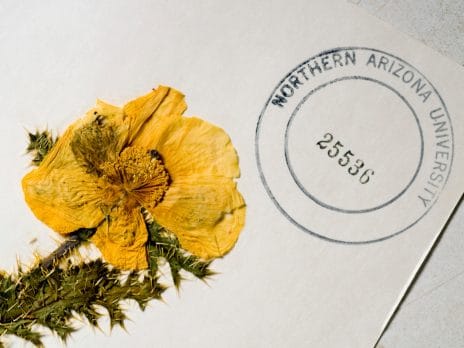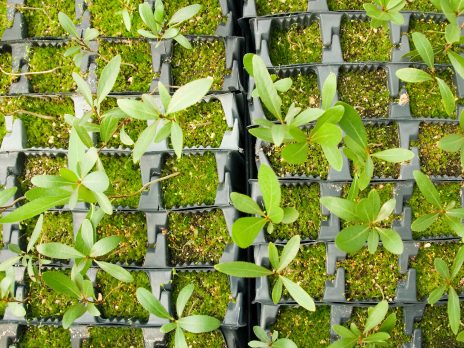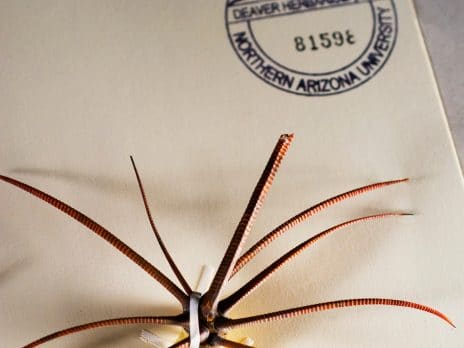 Herbarium Home Deaver Herbarium overview
Herbarium Home Deaver Herbarium overview  Staff Learn more about the staff at the Deaver Herbarium
Staff Learn more about the staff at the Deaver Herbarium  Education Support courses taught in Biological Sciences and create opportunities for graduate and undergraduate research and student curatorships
Education Support courses taught in Biological Sciences and create opportunities for graduate and undergraduate research and student curatorships  Services Resource for students, professional botanists, private consultants, and the Flagstaff community
Services Resource for students, professional botanists, private consultants, and the Flagstaff community Deaver Herbarium research
Floristic inventories at the Deaver Herbarium
Floristic inventories are catalogs of biological diversity at specific localities. These inventories are compilations of all historical botanical explorations combined with intensive multiyear collecting expeditions designed to discover all plants that occur in a particular area. Besides determining a total number of species for an area, floristic inventories result in the discovery of new state records, geographical distributions, and species new to science. Floristic inventories record non-native species and often track populations of rare, endemic species.
Christie, K. 2009. Phytogeography and floristics of pinyon-juniper woodlands in northern Arizona. Western North American Naturalist 69(2):155-164.
Christie, K. 2008. Vascular flora and floristic analysis of the lower San Francisco Volcanic Field, Coconino County, Arizona. Madrono 55:1-14.
Rink, G. 2005. A checklist of the vascular flora of Canyon de Chelly National Monument, Apache County, Arizona. The Journal of the Torrey Botanical Society 132(3): 510-532.
Vascular flora of the San Francisco Peaks
Will Moir compiled more than 800 species records for vascular plants of the San Francisco Peaks in northern Arizona. These historical collections include specimens collected by Elbert Little, James Morefield, the late Jim Rominger, and many NAU graduate students, including Clark Schaack and Laurie Paulik.
Deaver Herbarium staff members are still actively hunting the San Francisco Peaks for species that have not been found in the past 20 to 80 years, to revise the floristic inventory of the area created by Will, who is now living in northern California. Vascular Flora of the San Francisco Peaks (3rd edition), an online resource, provides the most current inventory of the vascular plants of the San Francisco Peaks, including life zones, environments, and species list.
Ethnobotany of the San Francisco Peaks
The ethnobotanical flora of Arizona’s San Francisco Peaks was documented by Kristin Kampe in her master’s thesis, which focused on medicinal and ceremonial plants used by 13 Native American Tribes that find the area sacred. This medicinal flora provides a comparative analysis of plant usage by these Tribes on the basis of application as well as by distribution of species.
Henningsen, K., T. Ayers, R. Scott, and P. Hogan. 2011. Medicinal flora of the San Francisco Peaks in northern Arizona: a historical compilation. Journal of the American Herbalists Guild 10(2): 18.22.
Discovery of new biodiversity
Sometimes botanical research leads to the discovery of species new to science. Student and staff members affiliated with the Deaver Herbarium have described new species that have been discovered as the result of floristic inventories, general collecting, or while doing revisions and monographs, which are intensive studies of a single genus of plants.
Pérez-Pérez, M. A., Ayers, T. J., & Amith, J. D. 2022. A new species of Lobelia (Campanulaceae: Lobelioideae) from the Sierra Madre Oriental, Mexico. Phytotaxa, 568(1), 1-7.
Johnson, E. and T. Ayers. 2022. Molecular phylogeny and taxonomic revision of the genus Diastatea (Campanulaceae: Lobelioideae). Systematic Botany 47: 61-84.
Allen, M.L. and T.J. Ayers. 2021. A revised classification of Glossopetalon (Crossomataceae) based on restriction site-associated DNA sequencing. Systematic Botany 46(3):562-572.
Morin, N. and T. Ayers. 2020. Seven new species and a new variety of Nemacladus (Campanulaceae, Nemacladoideae). Madroño. 67: 35-60.
Ayers, T., P. Sklenář and D. Fernández. 2017. A new species of Lysipomia (Campanulaceae) from Ecuador. Phytotaxa 297: 97-100.
Crawford, R., and T. Ayers. 2017. A new species of Loeseliastrum from the Little Colorado River, Arizona. Madroño 64: 51-58.
Rhodes, S. L., & Ayers, T. J. 2010. Two new taxa of Scutellaria section Resinosa (Lamiaceae) from Northern Arizona. Journal of the Botanical Research Institute of Texas 4(1):19-26.
Taylor, R. M., & Ayers, T. J. 2006. Systematics of Salvia pachyphylla (Lamiaceae). Madrono 53 (1):11-24.
Understanding the evolutionary history of plants
Phylogenetic studies help researchers understand how plants are related to each other and how morphology, or the form and structure of organisms, evolves in response to changing environments or pollinators. These studies are important to understanding the biogeography, or distribution, of a species, including where it evolved and how its geographical area has changed through time.
Becklund, E. and T. Ayers. 2022. The phylogeny of Errazurizia (Fabaceae: Amorpheae) and the new monotypic genus Eremopicta. Systematic Botany 47: 1012-1024.
Johnson, E. and T. Ayers. 2022. Molecular phylogeny and taxonomic revision of the genus Diastatea (Campanulaceae: Lobelioideae). Systematic Botany 47: 61-84.
Allen, M.L. and T.J. Ayers. 2021. A revised classification of Glossopetalon (Crossomataceae) based on restriction site-associated DNA sequencing. Systematic Botany 46:462-572.
Koopman, M. M., & Ayers, T. J. 2005. Nectar spur evolution in the Mexican lobelias (Campanulaceae: Lobelioideae). American Journal of Botany 92(3): 558-562.
Rare plant ecology
Deaver Herbarium staff and students study plants that are globally rare and of conservation concern. These studies often include collecting ecological data, common garden experiments, pollination biology, and/or molecular genetics.
Silva, S. and T. Ayers. 2016. Plant Endemism on Mancos Shale Barrens. Natural Areas Journal 36(2):166-173.
Johnson, E. and T. Ayers. 2015. Hybridization of a globally rare plant, the San Francisco Peaks Groundsel (Packera franciscana) with a lower elevation congener: evidence from morphometric and molecular data. Southwestern Naturalist 60(1): 56-60.
Palmquist, E., T. Ayers, and G. Alan. 2014. Genetic and Morphometric Assessment of the Origins and Taxonomic Status of Anticlea vaginata (Melanthiaceae). Systematic Botany 40(1):56-68.
Jabis, M., and T. Ayers. 2014. Causes of endemism in a federally listed species, Abronia alpina: 1 Dispersal limitation or habitat constraints. Western American Naturalist 74:185-200.
Jabis, M. D., Ayers, T. J., & Allan, G. J. 2011. Pollinator-mediated gene flow fosters genetic variability in a narrow alpine endemic Abronia alpine(Nyctaginaceae). American Journal of Botany 98:1583-1594.